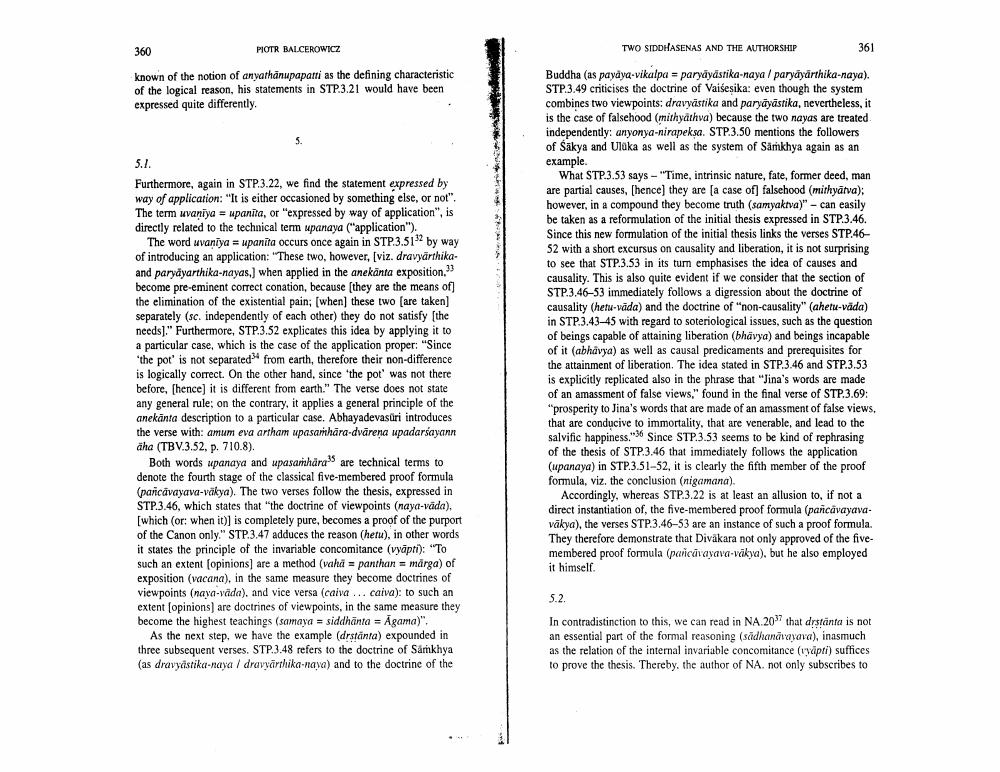Book Title: Two Siddhasenas And Authorship Of Nyayavatara And Sammati Tarka Pprakarana Author(s): Piotr Balcerowicz Publisher: Piotr Balcerowicz View full book textPage 6
________________ PIOTR BALCEROWICZ 360 TWO SIDDHASENAS AND THE AUTHORSHIP 361 known of the notion of anyathanupapati as the defining characteristic of the logical reason, his statements in STP.3.21 would have been expressed quite differently. 5.1. Furthermore, again in STP.3.22, we find the statement expressed by way of application: "It is either occasioned by something else, or not". The term wvaniya-upanila, or "expressed by way of application", is directly related to the technical term wpanaya ("application"). The word uvaniya = upanita occurs once again in STP.3.51" by way of introducing an application: "These two, however, (viz. dravarthikaand parydyarthika nayas, when applied in the anekanta exposition." become pre-eminent correct conation, because they are the means of] the elimination of the existential pain; (when) these two are taken] separately (sc. independently of each other) they do not satisfy (the needs]." Furthermore, STP.3.52 explicates this idea by applying it to a particular case, which is the case of the application proper: "Since "the pot' is not separated from earth, therefore their non-difference is logically correct. On the other hand, since the pot' was not there before, (hence] it is different from earth." The verse does not state any general rule, on the contrary, it applies a general principle of the anekanta description to a particular case. Abhayadevasűri introduces the verse with: amum eva artham wpasanthára.dvárena wpadarsayann äha (TBV.3.52, p. 710.8). Both words upanaya and upasanthara's are technical terms to denote the fourth stage of the classical five-membered proof formula (paricavayava-vakya). The two verses follow the thesis, expressed in STP.3.46, which states that the doctrine of viewpoints (naya-voda). [which (or: when it)] is completely pure, becomes a proof of the purport of the Canon only." STP.3.47 adduces the reason (heru), in other words it states the principle of the invariable concomitance (vyāpti): "To such an extent opinions are a method (vahd = panthan marga) of exposition (vacana), in the same measure they become doctrines of viewpoints (naya-voda), and vice versa (caiva ... caiva): to such an extent opinions are doctrines of viewpoints, in the same measure they become the highest teachings (samaya = siddhanta = Agama)". As the next step, we have the example (drstanta) expounded in three subsequent verses. STP.3.48 refers to the doctrine of Samkhya (as dravydstika-naya / dravarthika-naya) and to the doctrine of the Buddha (as payaya-vikalpa = paryayastika-naya/parydyarthika naya). STP.3.49 criticises the doctrine of Vai esika: even though the system combines two viewpoints: dravyastika and parāyastika, nevertheless, it is the case of falsehood (mithyathva) because the two nayas are treated independently: anyonya-nirapeksa. STP.3.50 mentions the followers of Sakya and Ulaka as well as the system of Samkhya again as an example. What STP.3.53 says - "Time, intrinsic nature, fate, former deed, man are partial causes, (hence) they are a case of] falschood (mithyatva): however, in a compound they become truth (samyakrva)" - can easily be taken as a reformulation of the initial thesis expressed in STP.3.46. Since this new formulation of the initial thesis links the verses STP.46 52 with a short excursus on causality and liberation, it is not surprising to see that STP.3.53 in its turn emphasises the idea of causes and causality. This is also quite evident if we consider that the section of STP.3.46-53 immediately follows a digression about the doctrine of causality Chetu-vāda) and the doctrine of "non-causality" (ahetu-vada) in STP.3.43-45 with regard to soteriological issues, such as the question of beings capable of attaining liberation (bhavya) and beings incapable of it (abhavya) as well as causal predicaments and prerequisites for the attainment of liberation. The idea stated in STP.3.46 and STP.3.53 is explicitly replicated also in the phrase that "Jina's words are made of an amassment of false views" found in the final verse of STP.3.69: "prosperity to Jina's words that are made of an amassment of false views that are conducive to immortality, that are venerable, and lead to the salvific happiness."36 Since STP.3.53 seems to be kind of rephrasing of the thesis of STP.3.46 that immediately follows the application (upanaya) in STP.3.51-52, it is clearly the fifth member of the proof formula, viz. the conclusion (nigamana). Accordingly, whereas STP.3.22 is at least an allusion to, if not a direct instantiation of the five-membered proof formula (pancavayava. vākya), the verses STP.3.46-53 are an instance of such a proof formula They therefore demonstrate that Divakara not only approved of the fivemembered proof formula (paricavayava vakya), but he also employed it himself. 5.2. In contradistinction to this, we can read in NA 20" that drstanta is not an essential part of the formal reasoning (sadhanavayava), inasmuch as the relation of the internal invariable concomitance (uyapti) suffices to prove the thesis. Thereby the author of NA, not only subscribes toPage Navigation
1 ... 4 5 6 7 8 9 10 11 12 13 14
